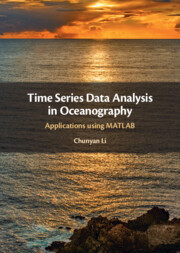Book contents
- Time Series Data Analysis in Oceanography
- Time Series Data Analysis in Oceanography
- Copyright page
- Contents
- Preface
- Acknowledgments
- 1 Introduction
- 2 Introduction to MATLAB
- 3 Time and MATLAB Functions for Time
- 4 Deterministic and Random Functions
- 5 Error and Variability Propagation
- 6 Taylor Series Expansion and Application in Error Estimate
- 7 Spherical Trigonometry and Distance Computation
- 8 A System of Linear Equations and Least Squares Method
- 9 Base Functions and Linear Independence
- 10 Generic Least Squares Method and Orthogonal Functions
- 11 Harmonic Analysis of Tide
- 12 Fourier Series
- 13 Fourier Transform
- 14 Discrete Fourier Transform and Fast Fourier Transform
- 15 Properties of Fourier Transform
- 16 More Discussion on the Harmonic Analysis and Fourier Analysis
- 17 Effect of Finite Sampling
- 18 Power Spectrum, Cospectrum, and Coherence
- 19 Window Functions for Reducing Side Lobes
- 20 Convolution, Filtering with the Window Method
- 21 Digital Filters
- 22 Rotary Spectrum Analysis
- 23 Short-Time Fourier Transform and Introduction to Wavelet Analysis
- 24 Empirical Orthogonal Function Analysis
- References
- Index
9 - Base Functions and Linear Independence
Published online by Cambridge University Press: 21 April 2022
- Time Series Data Analysis in Oceanography
- Time Series Data Analysis in Oceanography
- Copyright page
- Contents
- Preface
- Acknowledgments
- 1 Introduction
- 2 Introduction to MATLAB
- 3 Time and MATLAB Functions for Time
- 4 Deterministic and Random Functions
- 5 Error and Variability Propagation
- 6 Taylor Series Expansion and Application in Error Estimate
- 7 Spherical Trigonometry and Distance Computation
- 8 A System of Linear Equations and Least Squares Method
- 9 Base Functions and Linear Independence
- 10 Generic Least Squares Method and Orthogonal Functions
- 11 Harmonic Analysis of Tide
- 12 Fourier Series
- 13 Fourier Transform
- 14 Discrete Fourier Transform and Fast Fourier Transform
- 15 Properties of Fourier Transform
- 16 More Discussion on the Harmonic Analysis and Fourier Analysis
- 17 Effect of Finite Sampling
- 18 Power Spectrum, Cospectrum, and Coherence
- 19 Window Functions for Reducing Side Lobes
- 20 Convolution, Filtering with the Window Method
- 21 Digital Filters
- 22 Rotary Spectrum Analysis
- 23 Short-Time Fourier Transform and Introduction to Wavelet Analysis
- 24 Empirical Orthogonal Function Analysis
- References
- Index
Summary
The objective of this chapter is to discuss the concept of base functions and the basics of using some simple base functions to represent other functions. These base functions are needed in many commonly used analyses. An example of using base functions to approximate an almost arbitrary target function is the Taylor series expansion we have discussed. Here we say that an “almost arbitrary function” is not really arbitrary because, in theory, the target function must be differentiable an arbitrary number of times for the Taylor series expansion to be valid. The concept of linear independence of functions is important in understanding the selection of base functions.
Keywords
- Type
- Chapter
- Information
- Time Series Data Analysis in OceanographyApplications using MATLAB, pp. 165 - 177Publisher: Cambridge University PressPrint publication year: 2022

